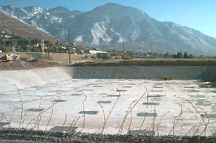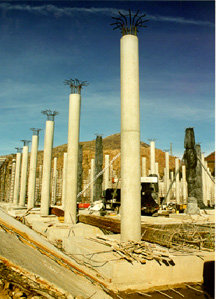Samuel C. Park Reservoir Rebuilt
Sixty-six year old reservoir rebuilt to increase capacity and meet seismic standards
July 27, 1998
|
Gerber Construction Company was awarded the low-bid contract of $3,483,000, with a start date of September 1, 1997.
|
|
On July 18, 1996, prior to the reservoir's construction, K & P Plumbing & Heating Inc. was awarded a $469,000 contract to install new piping to the reservoir site to allow for additional supply from the Little Dell Project in Parleys Canyon. The piping configuration increased the water supply capacity to the City's Park Reservoir and the Metropolitan Water District's 50 million-gallon Terminal Reservoir complex located directly south of the Park Reservoir. This juncture is a key element of the water system, receiving water from the Metropolitan Water District's Little Cottonwood Water Treatment Plant and Salt Lake Aqueduct, the City's Big Cottonwood Water Treatment Plant and Conduit, and now the Parleys Water Treatment Plant. Water supply from the reservoir complex is delivered to most of corporate Salt Lake City.
According to Scott Cardwell, Public Utilities Senior Engineer, "It was an engineering challenge to build the new reservoir within the old structure, and to have additional capacity without changing the size of the original footprint." Scott continues, "To build the additional capacity the structure was raised farther out of the ground. This reservoir is now the largest one the City owns." Scott credits, decisions made during construction led to the completion of the project in time to meet the summer water demand, when the storage is critical to the City.
The reservoir project is part of the Department of Public Utilities 5-year CIP that will expend $45.5 million to renovate the City's 122-year-old water system.

